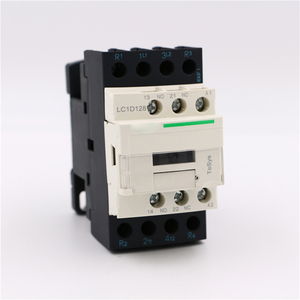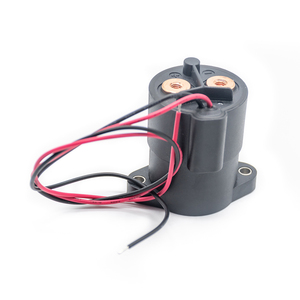
All categories
Featured selections
Trade Assurance
Buyer Central
Help Center
Get the app
Become a supplier

(5954 products available)








A DC contactor coil is one of the most important parts of an electrical device. It acts like the heart of the device, helping all the parts work smoothly. There are many kinds of coils, and each one helps with different tasks. Knowing the right type of coil to use is crucial for making sure things run well, especially when big machines are used.
AC Coils
An AC coil allows the contractor to operate on an AC power supply, even though the contingent itself is an essential device in DC systems. It is mostly used where cross-power sources are unavoidable. However, an AC coil can be used in DC systems, albeit with possible negative effects like lower performance or reduced lifespan.
Permanent Magnet DC (PMDC) Coils
These types of coils are often applied in electric contactor switches and other frameworks where it is important to minimize power consumption. PMDC coils work through a permanent magnet embedded within the coil's structure, which allows for less energy needs during activation, compared to regular DC coils.
Standard DC Coils
Standard DC coils are widely used across electrical contactors. They come with a simple structure and generate a magnetic field as current is passed through the wire wrapped around a core. The magnetic field pulls the contact points together and closes the switch. This will allow current to flow through, activating other parts of the system.
Smart Coils
Smart coils are high-tech coils. These coils have sensors and can communicate with computers. This makes it easier to manage and fix big systems. They are great for future-style systems that need better control and less downtime. One advantage that sets them apart is their ability to manage the spectrum of their operating conditions instantaneously.
Low Voltage Release Coils
Low-voltage release coils deactivate at lower voltages to ensure safety and reliability in sensitive systems. These coils are important in applications where power surges could be dangerous. By using low-voltage release coils, people ensure that their system never generates voltage above what users can safely tolerate.
High Voltage Coils
These coils are made to handle high voltages and are widely used in high power, large-scale applications. While such coils undertake high voltages with effortless transitions, they ensure proper sealing contractor mechanics are tightly held under safe conditions to contain precision.
A contactor coil, or coil for short, is mainly used for controlling a large electrical energy. In this part of the article, the features and functions of this coil would be discussed in detail.
Control Load Switch
The main purpose of the contactor is to control large electrical loads and switch devices such as motors, lights, or entire power systems. DC coils help the contractor close or open its contacts to control, then, this outburst of electrical flow with current ease.
Electromagnetic Field Generation
DC coils generate an electromagnetic field when current is supplied. That field pulls the contractor's contact, engaging it toallow current flow for desired functions.
Electromechanical Device
A coil of a contractor is an electromechanical device wherein one segment (the coil) is driven with electric current to accomplish mechanical motion by another segment to run appliances. It is the interplay of these two pronouncements that permits the contractor to perform its on-off function effectively.
Powering Devices
When the coil receives DC electrical power, it interacts with the contractors by providing the required input to keep its operations functional while turning on the output, or simply switching on the output of the contractors.
Low Power Requirement
DC coils have low power requirements, so they do not use much electricity. This makes them very efficient and helps save energy when switching on bigger devices.
The coil's materials also determine its durability. Below is a list of its constituent materials, along with how much effect they have on the part's life span.
Wire
Most of the coil's wire is made of copper. Copper is a good conductor of electricity. Sometimes, copper is coated with another type of thin metal called insulation varnish. This is because copper is expensive. Alternatively, aluminum wire is used, too. It's a cheaper but less durable option. It provides good conductivity and corrosion protection and is found in parts of the coil, mostly in lowpendant models.
Insulation Materials
The insulation helps prevent electricity from going where it shouldn't. This is important so that the coil works properly and safely. The materials used for insulating include epoxy resins, fluoropolymer, and polyimide. These materials allow the coil to withstand the expected temperature levels without breaking down or causing a short circuit. If the insulation damages, the coil becomes harmful to use because it can short-circuit or ignite.
Core
A contractor coil is normally a core made of a magnetic substance such as iron or steel. Cores usually come with a high permeability mark, as this feature enables magnetic fields to hold better. If the core cannot hold the magnetic field very well, the contactor would not function as desired. The core facilitates the induction of the electromagnetic field when the current flows through the wire.
Sealants and Coatings
Sealants and coatings protect the coil from moisture, dust, and chemicals. These elements can break down the coil over time. Manufacturers frequently apply sealants and coatings to coils used in extreme or outdoor conditions. Silicone, polyurethane, and polyester are mostly used to coat Coil and Sealants.
Extreme conditions
Operation under extreme conditions can significantly shorten the coil's lifespan. Excessive exposure temperatures heat, humidity, or dust can degrade its materials, causing insulation failure, wire breakage, or core demagnetization. To avoid this, it is important to practice regular maintenance and replace damaged parts timely.
In this section, various scenarios in which a contactor coil is vital to electrical systems will be discussed. Knowing these situations helps people understand how important the coil is so that big systems run smoothly.
Industrial Factories
In factories, machines like motors, conveyors, and big fans need a lot of power. The coil helps these machines turn on and off safely. This is because the coil controls the high power of these machines without directly using high voltage switches. This protects the switches from damage.
Commercial Buildings
Coils in commercial buildings help control the lighting and air conditioning systems. They make it possible to operate large systems with HVAC contactors that are often installed in electrical panels. These panels are easily accessed for maintenance. The coils help save energy by turning off lights or air conditioning when not needed.
Power Systems
Coils also work in power distribution systems that switch circuit breakers or disconnect switches. In this case, the coil provides isolation control over high-power electrical circuits. Once isolations are operated, the coil reduces risks of sparks or arcing while enhancing the system's safety feature by providing power of control.
Commercial Vehicles
Large transportation systems such as buses or trucks, often use coils to control big electrical loads like battery charging systems. The coil will allow these vehicles to operate safely with fewer risks to the driver's safety and the people outside by eliminating the direct access of high-voltage wiring with the operator and the service personnel. They are used to switch on electric motors, generators, or air conditioning units.
Outdoor Power Equipment
Outdoor power equipment like electric sprinklers or garden equipment contains coils. Coils act as seals indemnifying external contaminants like dirt or moisture from entering into the electrical enclosure. These are often exposed to rough environmental conditions. These parts must be robustly constructed to prevent effects from dust, moisture, and temperature changes.
Choosing the right coil for the contact electrical switch depends on many factors. Below are some of those factors.
Application Requirements
What will the coil be used for? Will it be used for indoors or outdoors? What kind of temperature will it face? Knowing these will help determine the kind of materials and parts that will be needed.
Voltage Rating
The coil must be able to handle the voltage level that will be used. These voltage levels can be high, medium, or low. The coil must not be too powerful or weak. If the coil receives too much voltage, it will break. If it receives too little, it will not work at all.
Current Rating
The current rating is also critical. People need to ensure that the coil's current rating matches the load it will switch on. If the coil's current rating is too low, it will overheat and shut down the system. If its rating is too high, the coil will not perform well either.
Durability
How long does the client want the coil to last? Some coils are made more durable than others. For instance, outdoor coils resist corrosion and moisture are more durable. People should get stronger coils for high-load operations.
Insulation
Coils have insulation to separate the electrical current from the other parts. This will prevent short circuit from happening if the coil is exposed to things that can cause it to overheat. Standard DC coils have a simple insulation system, while PMDC and smart coils have special insulations.
Coil Type
Manufacturers produce different coils to be used in different situations. As stated above, they can be either standard DC, AC, PMDC, or even smart coils. Each of them has positive and negative effects. So, it is a must for the buyer to understand and weigh out all of them out well.
A1: A DC contactor coil is an electrical part that controls larger electric current. It does this by creating a magnetic field when direct current flows through it. This magnetic field switches the contactor on or off.
A2: A DC coil and AC coil differ primarily in their electromagnetic field induction. A DC coil generates a steady field through constant current as direct current flows. While an AC coil generates a changing field, producing alternating current creates dynamic fields with flux concentration to provide better stability. This magnetic condition discrepancy gives rise to their usage in different voltage environment scenarios.
A3: A contact coil can last between 5 to 15 years. This number varies depending on how much power goes through it, how hot or cold it gets, and the condition of the air around it. If the contactor is maintained well, it can last even longer.
A4: Standard DC coils are the most common type of coils used in contactors because they are simple and efficient to control electrical loads.
A5: To know if the coil is bad, just check for these signs. If the contactor does not turn on at all even if it is getting power, look at the coil, there might be a problem. Also, if it turns on and off a lot by itself, ringing or buzzing, there is likely a coil problem. Another sign is if the coil gets really hot. Some models have a way of showing errors on the system. If the error code refers to the coil, then it is bad.